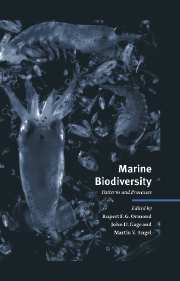Book contents
- Frontmatter
- Contents
- List of contributors
- Foreword: The value of diversity
- 1 Marine biodiversity in its global context
- 2 Gradients in marine biodiversity
- 3 Pelagic biodiversity
- 4 Biological diversity in oceanic macrozooplankton: More than counting species
- 5 Large-scale patterns of species diversity in the deep-sea benthos
- 6 Diversity, latitude and time: Patterns in the shallow sea
- 7 High benthic species diversity in deep-sea sediments: The importance of hydrodynamics
- 8 Diversity and structure of tropical Indo-Pacific benthic communities: Relation to regimes of nutrient input
- 9 Why are coral reef communities so diverse?
- 10 The biodiversity of coral reef fishes
- 11 The historical component of marine taxonomic diversity gradients
- 12 Population genetics and demography of marine species
- 13 Discovering unrecognised diversity among marine molluscs
- 14 Ecosystem function at low biodiversity – the Baltic example
- 15 Land–seascape diversity of the USA East Coast coastal zone with particular reference to estuaries
- 16 The development of mariculture and its implications for biodiversity
- 17 Protecting marine biodiversity and integrated coastal zone management
- 18 Conserving biodiversity in North-East Atlantic marine ecosystems
- Author index
- Species index
- Subject index
13 - Discovering unrecognised diversity among marine molluscs
Published online by Cambridge University Press: 04 August 2010
- Frontmatter
- Contents
- List of contributors
- Foreword: The value of diversity
- 1 Marine biodiversity in its global context
- 2 Gradients in marine biodiversity
- 3 Pelagic biodiversity
- 4 Biological diversity in oceanic macrozooplankton: More than counting species
- 5 Large-scale patterns of species diversity in the deep-sea benthos
- 6 Diversity, latitude and time: Patterns in the shallow sea
- 7 High benthic species diversity in deep-sea sediments: The importance of hydrodynamics
- 8 Diversity and structure of tropical Indo-Pacific benthic communities: Relation to regimes of nutrient input
- 9 Why are coral reef communities so diverse?
- 10 The biodiversity of coral reef fishes
- 11 The historical component of marine taxonomic diversity gradients
- 12 Population genetics and demography of marine species
- 13 Discovering unrecognised diversity among marine molluscs
- 14 Ecosystem function at low biodiversity – the Baltic example
- 15 Land–seascape diversity of the USA East Coast coastal zone with particular reference to estuaries
- 16 The development of mariculture and its implications for biodiversity
- 17 Protecting marine biodiversity and integrated coastal zone management
- 18 Conserving biodiversity in North-East Atlantic marine ecosystems
- Author index
- Species index
- Subject index
Summary
Abstract
The biology of closely related and recently separated species is of special interest in the study of speciation. Recognition of the status of such populations presents problems – it is not always easy to discriminate which populations are fully reproductively isolated from those where some hybridisation between ‘species’ occurs. In our chosen study organism, Littorina saxatilis in the prosobranch subgenus Neritrema, there is still considerable controversy over which populations are in a state of gene flow with which others. Recent opinion holds that there are three differentiated sibling species: L. saxatilis, L. arcana and L. nigrolineata, with the status of the small barnacle-dwelling L. neglecta still controversial. In this chapter, we question the genetic unity of L. saxatilis sensu stricto, and discuss the relative importance of study of shell morphology, enzyme polymorphisms and DNA polymorphisms. We conclude that in this organism, enzyme polymorphisms are a weak tool for the study of sibling species.
Introduction
A ‘species’ is often held to comprise a group of populations that freely exchange genes among themselves, but not with other groups. The idea of species is, for some workers, fundamental in biology and studies of biodiversity (e.g. Futuyma, 1987), and indeed inasmuch as species are genetically circumscribed units, this has force. Our opening sentence is an expression of the Biological Species Concept (BSC) especially associated with Mayr (e.g. Mayr, 1963) – there are other species concepts.
- Type
- Chapter
- Information
- Marine BiodiversityPatterns and Processes, pp. 293 - 318Publisher: Cambridge University PressPrint publication year: 1997
- 3
- Cited by



